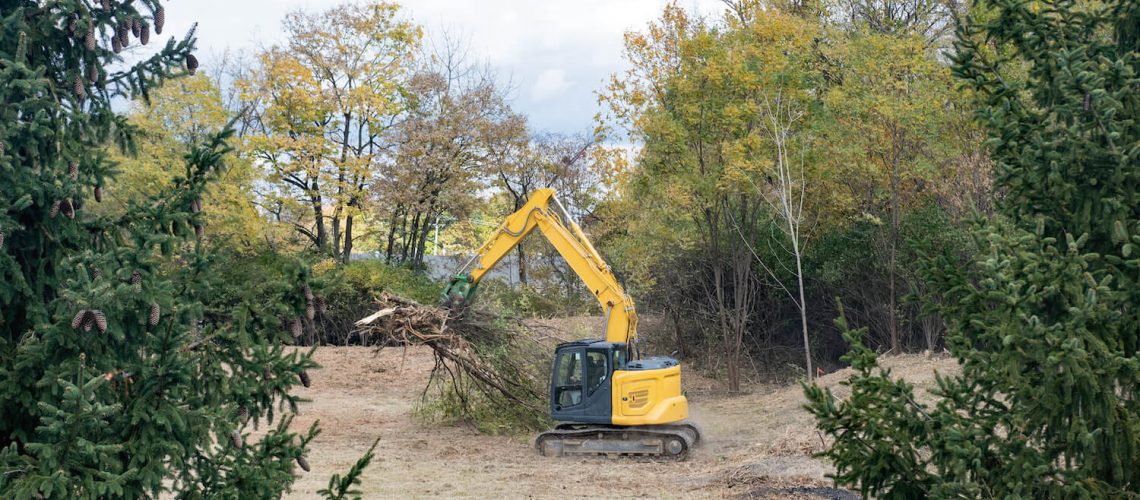Landscapes have always played a pivotal role in determining the value of a property. Beyond just aesthetic appeal, the condition and use of the land can significantly impact its market value. One key aspect that property owners often overlook is the importance of land clearing. The process of removing trees, bushes, and other vegetation might seem counterintuitive at first, but when done strategically, land clearing can enhance property value in various ways.
This article delves into the multifaceted benefits of land clearing and its role in shaping the evolving landscapes of real estate.
Enhanced Aesthetics and Curb Appeal
The first impression is crucial when it comes to real estate. Potential buyers are more likely to be drawn to a property with a well-maintained and clear landscape. Overgrown vegetation, dead trees, and unkempt greenery can make a property appear neglected and uninviting. Land clearing provides an opportunity to create a clean slate, allowing for better landscaping possibilities.
By removing obstacles and eyesores, the property becomes visually appealing, enhancing its curb appeal. This initial attraction can make a significant impact on the perceived value of the property. A property with a manicured and well-cleared landscape is more likely to command attention and stand out in a competitive real estate market.
Expanded Usability and Functionality
Land clearing goes beyond mere aesthetics; it opens up new possibilities for the use of the land. Large, overgrown areas may limit the functionality of the property, leaving potential untapped. Clearing the land can reveal hidden potential for additional structures, outdoor spaces, or landscaping features that can contribute to the property’s overall appeal and utility.
For example, a property with cleared land may offer space for a garden, a swimming pool, or an outdoor entertainment area. Such additions can significantly increase the property’s value by expanding its functional aspects, catering to the diverse needs and preferences of potential buyers.
Fire Mitigation and Safety
In many regions, especially those prone to wildfires, land clearing is a critical safety measure. Overgrown vegetation can act as fuel for fires, increasing the risk of property damage and endangering lives. By strategically clearing the land, property owners not only reduce the risk of wildfires but also enhance the safety of the property and its surroundings.
Insurance companies often take fire risk into account when determining premiums, and a well-maintained, cleared property may qualify for lower insurance costs. This reduction in potential risks and associated costs can positively influence the property’s overall value.
Environmental Considerations
While land clearing is often associated with removing vegetation, it doesn’t necessarily imply disregard for the environment. Responsible land clearing practices involve careful planning to minimize the environmental impact. Selective clearing, for instance, allows property owners to retain valuable trees and vegetation while removing unwanted or hazardous growth.
Furthermore, the cleared land can be repurposed in environmentally friendly ways, such as creating green spaces, planting native species, or implementing sustainable landscaping practices. A property that demonstrates a commitment to environmental responsibility may appeal to a growing segment of environmentally conscious homebuyers, positively influencing its market value.
Infrastructure Development
Land clearing is often a precursor to infrastructure development. Whether it’s preparing the land for construction or creating space for essential utilities, clearing the land is a necessary step in enhancing the property’s infrastructure. This can include the installation of driveways, pathways, or even the laying of foundations for additional structures.
Improved infrastructure can significantly increase the property’s functionality and accessibility, contributing to its overall value. For instance, a cleared space that allows for the construction of a garage or a guesthouse adds to the property’s appeal, providing potential buyers with valuable amenities that may influence their decision-making.
Increased Land Scarcity and Work Demand
As urbanization continues to expand, the availability of open land decreases, contributing to increased land scarcity. Cleared and well-maintained properties become even more valuable in such scenarios, as they offer a ready-to-use solution for potential buyers. The demand for properties with cleared land is likely to rise as individuals seek turnkey solutions for their housing needs.
Additionally, the scarcity of open land can drive up property values, making well-cleared properties more lucrative investments. Investors looking for properties with development potential are more likely to be attracted to cleared land, recognizing the ease and cost-effectiveness of building on a prepared site.
Financial Considerations and Return on Investment
While land clearing incurs initial costs, the potential return on investment (ROI) can be substantial. The enhanced property value resulting from improved aesthetics, functionality, safety, and infrastructure can outweigh the initial expenses. Property owners should view land clearing as a strategic investment that can yield long-term financial benefits.
The ROI of land clearing extends beyond the immediate property value increase. As the property becomes more attractive to potential buyers, it is likely to spend less time on the market, reducing holding costs and increasing the efficiency of the sale. Additionally, the perceived value of the cleared land may allow property owners to command higher selling prices.
Regulatory Compliance and Zoning Requirements
Land clearing is often subject to local regulations and zoning requirements. Property owners must be aware of these regulations and obtain the necessary permits before initiating any clearing activities. Adhering to these guidelines not only ensures legal compliance but also contributes to the sustainable development of the property.
Failure to comply with regulations can result in fines and legal complications, negatively impacting the property’s value. On the other hand, demonstrating a commitment to compliance can enhance the property’s reputation and appeal, attracting buyers who prioritize transparency and adherence to legal standards.
Emerging Trends in Sustainable Land Clearing
As the global focus on sustainability and environmental consciousness grows, the methods employed in land clearing are undergoing transformation. Sustainable land clearing practices prioritize minimizing environmental impact, preserving biodiversity, and promoting long-term ecological health. These emerging trends align with the increasing demand for eco-friendly solutions in real estate and contribute to the overall value of a property.
One notable trend is the adoption of mechanized equipment designed for precision clearing. This allows property owners to selectively remove unwanted vegetation while preserving valuable trees and minimizing soil disturbance. The use of technology, such as GPS-guided equipment, enhances the efficiency of the clearing process and reduces the potential for unintended environmental consequences.
In addition to selective clearing, property owners are increasingly embracing reforestation efforts. After clearing undesirable vegetation, replanting with native species promotes biodiversity and contributes to the restoration of natural ecosystems. This approach not only supports environmental sustainability but also enhances the visual appeal of the property by creating a harmonious balance between development and nature.
Moreover, some property owners are exploring alternative uses for cleared vegetation, such as mulching or biomass conversion. Rather than disposing of cleared materials, these methods turn them into valuable resources, reducing waste and supporting a circular economy. The incorporation of sustainable practices in land clearing aligns with the preferences of environmentally conscious buyers, adding to the overall desirability and marketability of the property.
Challenges and Considerations in Land Clearing
While the benefits of land clearing are evident, it is essential to acknowledge the challenges and considerations associated with this process. Environmental impact, habitat disruption, and the potential for soil erosion are critical factors that must be carefully addressed. Property owners and developers should prioritize responsible land clearing practices to mitigate these challenges and contribute to sustainable development.
Furthermore, the cultural and historical significance of certain trees or vegetation should be taken into account during the land clearing process. Local communities may place value on specific natural elements, and their preservation can foster positive relationships between property owners and the community. Consulting with environmental experts, arborists, and community stakeholders can help strike a balance between development goals and cultural preservation.
In some regions, regulatory frameworks governing land clearing are becoming more stringent to address environmental concerns. Property owners must navigate these regulations and obtain the necessary permits to avoid legal complications and fines. Investing time and resources in compliance not only safeguards against legal issues but also demonstrates a commitment to responsible land management.
Conclusion: Navigating the Future of Property Development
As the real estate landscape continues to evolve, so too does the role of land clearing in shaping property values. Property owners, developers, and investors must embrace a holistic approach that considers aesthetics, functionality, environmental sustainability, and community impact. The evolving trends in sustainable land clearing reflect a broader shift towards responsible and eco-conscious development practices.
By recognizing the diverse benefits of land clearing and staying abreast of emerging trends, stakeholders in the real estate industry can make informed decisions that enhance the value of their properties. As technology advances and environmental awareness deepens, the integration of sustainable practices in land clearing is likely to become not just a trend but a standard in responsible property development.
In conclusion, the evolving job landscapes of real estate are intrinsically tied to the responsible and strategic management of a lot.
Land clearing, when executed with foresight and consideration, emerges as a powerful tool for transforming properties into valuable assets. As the demand for well-maintained, functional, and environmentally conscious properties continues to rise, the significance of land clearing in enhancing property value is poised to grow, shaping the future of real estate development.

